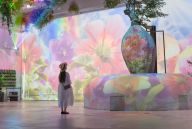A refreshing exploration of cities in Japan during the summertime, from Tokyo city to Hokuriku and Shinetsu regions
*This article is based on the information as of September 2022 and the latest status may have changed.
Check out the overall itinerary!
Day 1:Tokyo activity (Hana Biyori → Edo Kiriko, Okonomiyaki)
Day 2:Take the Tateyama Alpine route → Mount Tateyama → Kurobe Dam (All in Toyama)
Day 3:Kanetsuri Kawara → Kurobe Gorge Railway → Unazuki Onsen (All in Toyama)
Day 4:Samurai Residence → Sake Bar (All in Kanazawa)
Day 5:Shiraito Falls → Karuizawa City Walk & Cycling → The Prince Shopping Plaza (All in Karuizawa) → Matsumoto Castle (Matsumoto)
Day 6: Chubu Sangaku National Park (Nagano) → Kamikochi (Matsumoto)→ Shinjuku
In this article, I would like to introduce you to the first two days of our itinerary! It was a great start, using Tokyo as a gateway on day one and exploring the popular Tateyama Kurobe Alpine Route in Hokuriku and Shinetsu regions on day two.
Kurobe is a city in Toyama Prefecture which is surrounded by the Hida Mountains and popular for its hot spring villages and ski areas. My itinerary offers a unique overview of Japan's rich natural sceneries, hidden hot springs and a spectacular railway. There are experiences you’ll only find in Toyama Prefecture, including a rainbow over the dam, a secret onsen, and a railway in between Unazuki and Keyakidaira stations with breathtaking views.

Day 1: The Modern and Traditional Tokyo
Tokyo and its everchanging cityscape are constantly welcoming new and interesting facilities. For this itinerary, I had the opportunity to visit the amazing HANABIYORI. It is the first virtual botanical garden in Japan and is located in Yomiuri Land, just by the Keio Yomiuri Land Station. You can get here from Shinjuku Station within 30 minutes via the Keio Line. HANABIYORI features vibrant floral chandeliers, digital art and loads of Instagram-worthy photo spots. The Starbucks here is a must-visit, with gorgeous botanical designs surrounded by plants, natural light and beautiful greenery.
After kicking off my morning with a relaxing cup of coffee here, I headed over to Asakusa for a traditional Japanese cultural experience.


Upon reaching Asakusa, I was excited to try creating a one-of-a-kind Edo faceted glassware in Sokichi(創吉). This type of glassware bears the name Edo Kiriko, originating from the Edo period and mainly produced in Tokyo. Fans of sake beverages must have seen this before, as sake cups at sake bars or restaurants often feature this design.
Even though the process was trickier than expected, I was so happy upon receiving my finished products. I worked hard to make them, and the result was incredibly beautiful!

Since I was already in Asakusa, I decided to visit Tokyo Skytree. It took me only about 20 minutes to walk from Sokichi. The walkway is lined with shops that have inherited the core value of craftsmanship and atmosphere reminiscent of the Edo period.
After getting my tickets, I headed to the observation deck. Fortunately, it was a clear day and I was thrilled by the breathtaking view of Tokyo. What an incredible experience!

After a long day of sightseeing in Tokyo, let’s end the day with monjayaki!
Monjayaki is a type of savory pancake that originated in the Tsukishima area. It can be accessed from Oshiage Station, where Tokyo Skytree is located, with only one train transfer at Kiyosumi-Shirakawa. A key part of the monjayaki experience is cooking it yourself at the table. Once my warm monjayaki was ready to eat, it was a delightful wrap to the day for all of us!
Stay tuned for day two, where we head to the Hokuriku and Shinetsu area.

Day 2: Off to explore the Toyama Alpine Route
As they say, the early bird catches the worm, so I woke up at dawn and got ready for the first leg of my journey! The Tateyama Kurobe Alpine Route is a convenient and popular route for many to access the Hokuriku and Shinetsu regions. I departed from Shinjuku station and headed to Shinano-Omachi by Azusa Express train, and transferred at Shinano-Omachi to Ogisawa via bus. The area between Ogisawa and Tateyama is known as the Alpine Route!
There are a variety of transportation options to help us get up the high-altitude terrain, and it’s super easy to get to Murodo, the highest point along the Tateyama Kurobe Alpine Route. Even though the weather was very warm in Tokyo when I started, I could breathe easily outdoors on the mountain peak without sweating. The beautiful natural scenery makes us feel like I’m on top of the world, and it’s also a cool retreat to escape the summer heat as the temperature rarely exceeds 20°C even on the warmest days.


After loads of photos were taken at Mount Tateyama, I moved to our next spot, Kurobe Dam. Only 40 minutes by Tateyama’s ropeway and the Kurobe cable car, a whole new level of cool awaits! I was lucky enough to visit this place on a sunny day. The intense velocity of the water gushing out from the dam created a misty shower, casting a gorgeous rainbow in the sunlight!
You might be curious about why the dam is a popular spot for sightseers here. As simple as it sounds: crowds actually gather at the Kurobe Dam for the impressive view of 10-15 tons of water gushing out from the highest point, per second! If you are looking for great photo points, head out onto the observation deck, staircase and the new viewing deck called the Rainbow Terrace.

Day two has come to a close. I’m excited for day three, as it’s all about onsens tomorrow. As a preview: I’m off to a mysterious, hidden hot-spring resort accessible from the Tateyama Kurobe Alpine Route called Unazuki Onsen.
2nd Article is here
3rd Article is here




















































